Lincoln Park Conservatory: A Realistic Review
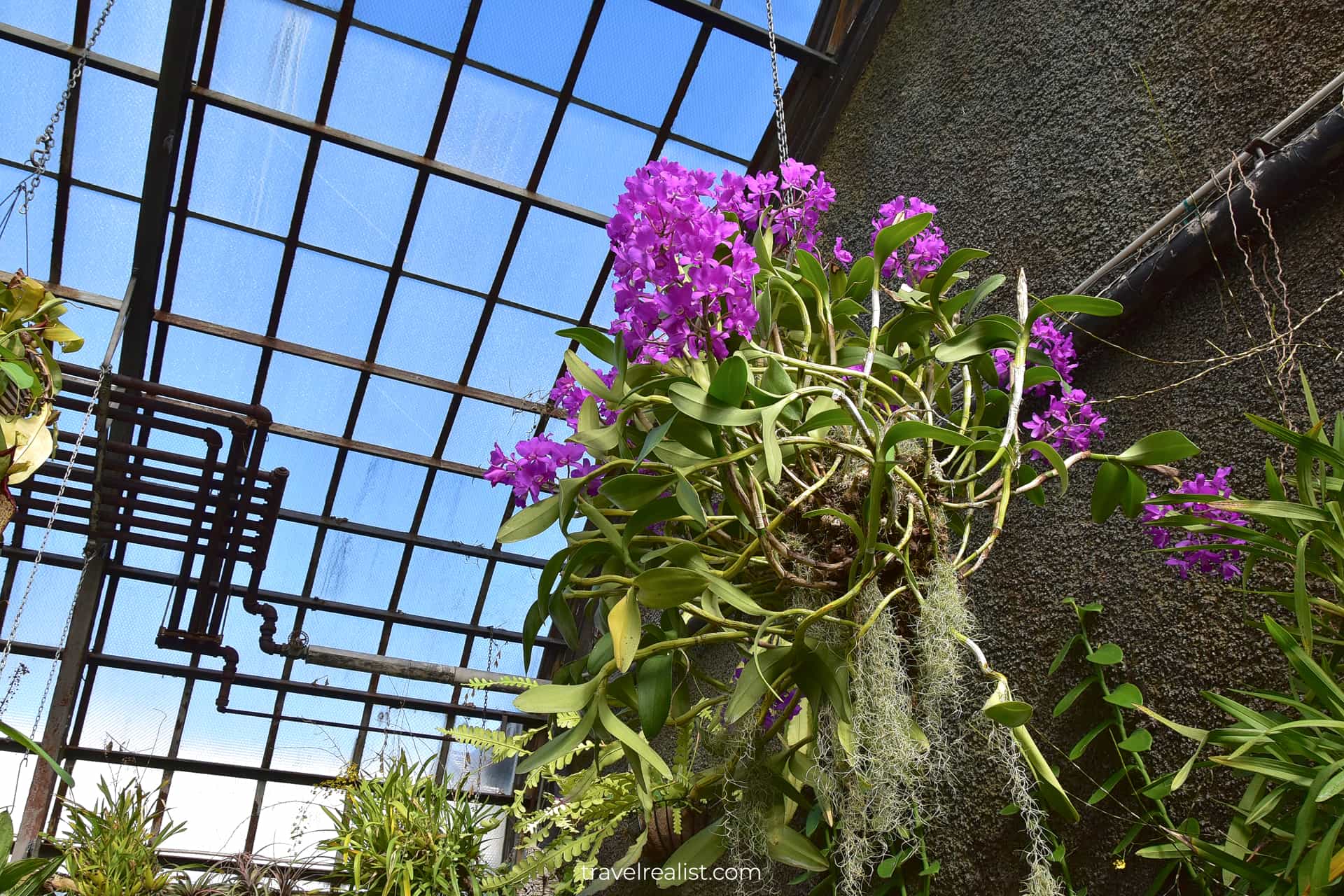
This realistic Lincoln Park Conservatory Review helps you plan your next adventure in this Chicago greenhouse.
The Lincoln Park Conservatory is a historic greenhouse in Chicago, Illinois. This Victorian Glass Building continues to attract visitors for over 125 years.
This post includes affiliate links that will earn us commission if you make a purchase via these links.
Sights & Places of Interest
The Lincoln Park Conservatory goes back to 1895. It is 12 years older than the larger Garfield Park Conservatory in another Chicago park.
Like a handful of other buildings in Chicago and surrounding areas, it is an architectural landmark. A historic greenhouse, gardens, ponds, and monuments round up a visit to this park.
There is plenty to see in Lincoln Park even if you are not a plant person. Check out a free zoo or a 120-year old cafe that still serves food and beverages.
This Lincoln Park Conservatory Review walks you through the main chambers of the greenhouse. You will start and finish your visit in the Palm House. You could explore three other rooms in any sequence.

1. Palm House
The Palm House is the first and largest room in the Lincoln Park Conservatory. It has two indoor ponds and a paved loop walk. You will find 12 different palm types in this display room.
Countless tropical bushes, grasses, and plants are the live exhibits in the Palm House. This Lincoln Park Conservatory Review follows a counterclockwise exploration path.
It first goes through the Palm House before entering the Fern Room. You could then enjoy flowers at the Orchid House before returning via the Show House.

1.1. Sausage Tree
You are certain to notice a Kigelia tree as soon as you set foot in the Palm House. This tree is also commonly known as a sausage tree. The sausage trees grow in topical or subsaharan Africa.
This tree grows large brown fruit that look a bit like sausages. The fruit gave Kigelia tree its colloquial name. While the fruit are responsible for the name, they do not look particularly appetizing.
It is likely for the better. The sausage tree fruit are poisonous for raw consumption. Still, it is possible to eat them after cooking. Other common use cases include traditional medicine.

1.2. Clementine Tree
Not all trees in Lincoln Park Conservatory are toxic to humans and pets. There are a handful of plants with perfectly edible fruit.
A Clementine tree is one of them. If you visit the conservatory in the fall, you have a good chance of seeing this tree full of clementines. A spring visit will give you a front row seat to a blooming fruit tree.
It is hard to say whether white blossoms or orange fruit make this tree more beautiful. As it is customary in botanical gardens, you could touch the plants. But plucking fruit, leaves, or branches is off-limits.

1.3. Buddha’s Hand
In fact, you should interact with the next plant in the Palm House. If a conservatory employee happens to be nearby, they might even encourage you to touch Buddha’s Hand.
This strange looking plant has an interesting name. You might not feel comfortable holding it without knowing its qualities and toxicity.
But Buddha’s Hand is just a type of citron that originated in Asia. The fruit have distinct sections that resemble fingers. They are responsible for the name of the plant.
Like other citrus plants, Buddha’s Hand has a strong fragrance. You will feel it as soon as you touch the fruit. This knowledge should empower you to keep exploring the Lincoln Park Conservatory.

1.4. Papaya
Buddha’s Hand and Clementine Tree are not the only edible fruit trees in this conservatory. You will see a papaya fruit tree a short distance from Buddha’s Hand.
Papayas originated in Central America. They have since been brought to other regions of the world. It is quite fascinating to watch these berries grow and ripen.
The green berries might look little like the bright orange ripen fruit you see at your local grocery store. But you could still find some resemblance in the shape.

1.5. Nerve Plant
The Palm House in the Lincoln Park Conservatory does not just have fruit trees and palms. There are also plenty of other, non edible, tropical plants. Take a nerve plant as an example.
This plant is native to the rainforests of South America. You could recognize it by dark green leaves and white vein lines. The plant creates a living mosaic, which partly explains its other name, a Mosaic Plant.

1.6. Loeseneri Calathea
As you continue to enjoy the exotic plants in the Palm House, stop by Loeseneri Calathea. This is another plant variety that originated in South America.
You might see some similarities with Calathea Makoyana, or the Peacock Plant. Since both plants belong to the same family, their leaves have similar consistency and shape.
But Loeseneri Calathea is called Brazilian Star Calathea for a reason. This plant has beautiful white and pink flowers that grow on a long stem above the leaves.

1.7. Pilea Cadierei
As you finish the loop walk in the Palm House, you will see plants from across the world. Piladea Cadierei, the Aluminum Plant, is a native of China.
This plant is an evergreen perennial. It is a resilient houseplant if you are looking for a new companion. You could even grow it outdoors in the warmer parts of the United States, like American Southwest.
Pilea blooms in the fall. Rather than having one flower like Calathea it has a few inflorescences. The off white flowers do not produce any scent.

2. Fern Room
The Palm House connects to all other display rooms in the conservatory. You could go to the Fern Room, the Show House, or take a passage to the Orchid House. It is up to you what path you take.
This Lincoln Park Conservatory Review goes to the Fern Room next. This room is down a flight of stairs on the way in. You would need to go up a similar flight of stairs on the way out of the room.
Different varieties of ferns make up the majority of plants in the Fern Room. Ferns live and thrive on the forest floor in the wild. Fun fact: you will never see flowers or seeds on a fern.
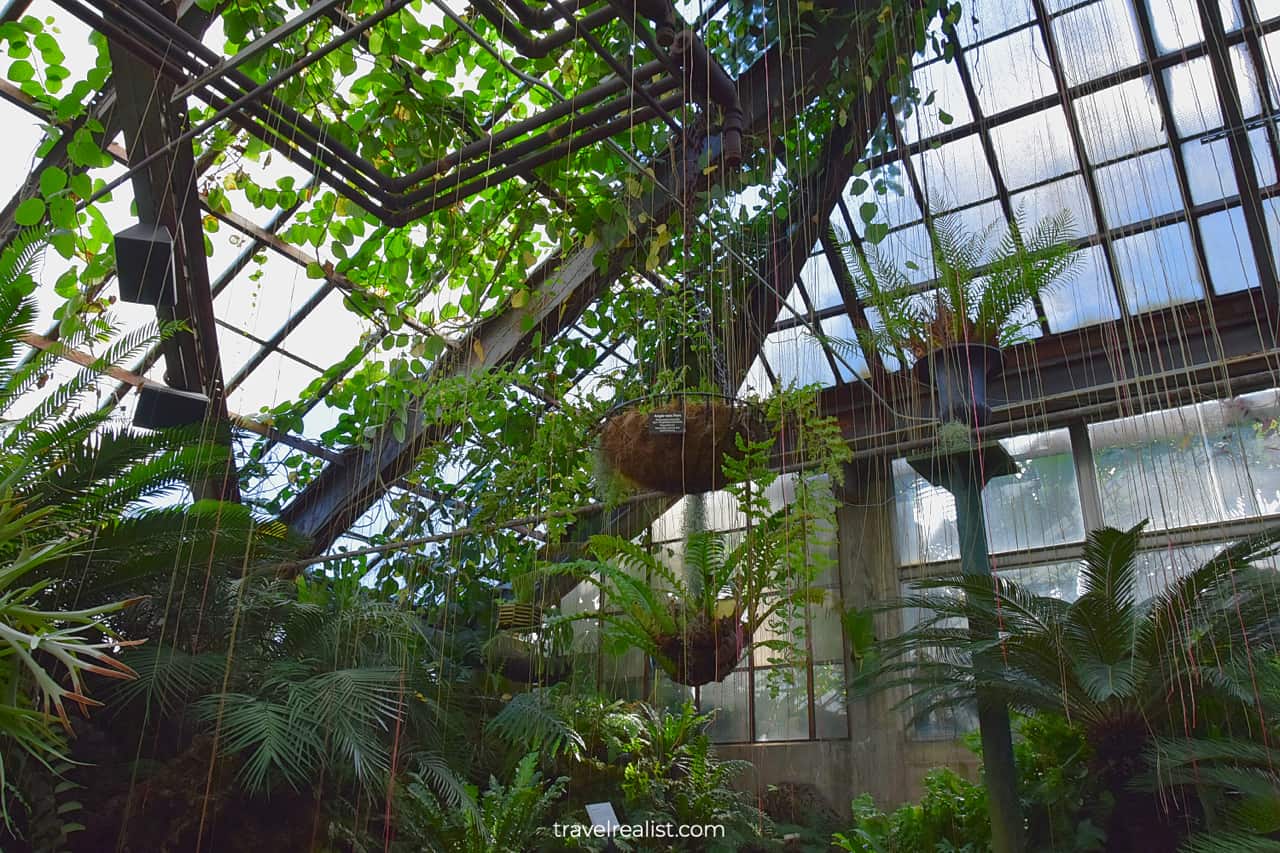
2.1. Cycad
While ferns are the main plants in this section of the conservatory, cycads steal the show as the most valuable. Cycads date back some 250 million years. It makes them some of the oldest plants on Earth.
You might not even know that you are looking at a cycad. Many visitors often mistake them for palms and ferns. In a way, you do not need to be a rocket scientist to see why.
A handful of cycads have palm looking trunks. Their leaves look just like the fern leaves on the forest floor. But a combination of fern leaves on a palm trunk is a proven way to tell these plants apart.
There are also other things to check to confirm whether you are looking at a cycad or a palm. See if there are any cones or small leave scars on the stem. Both are sure signs that you ran into a cycad.
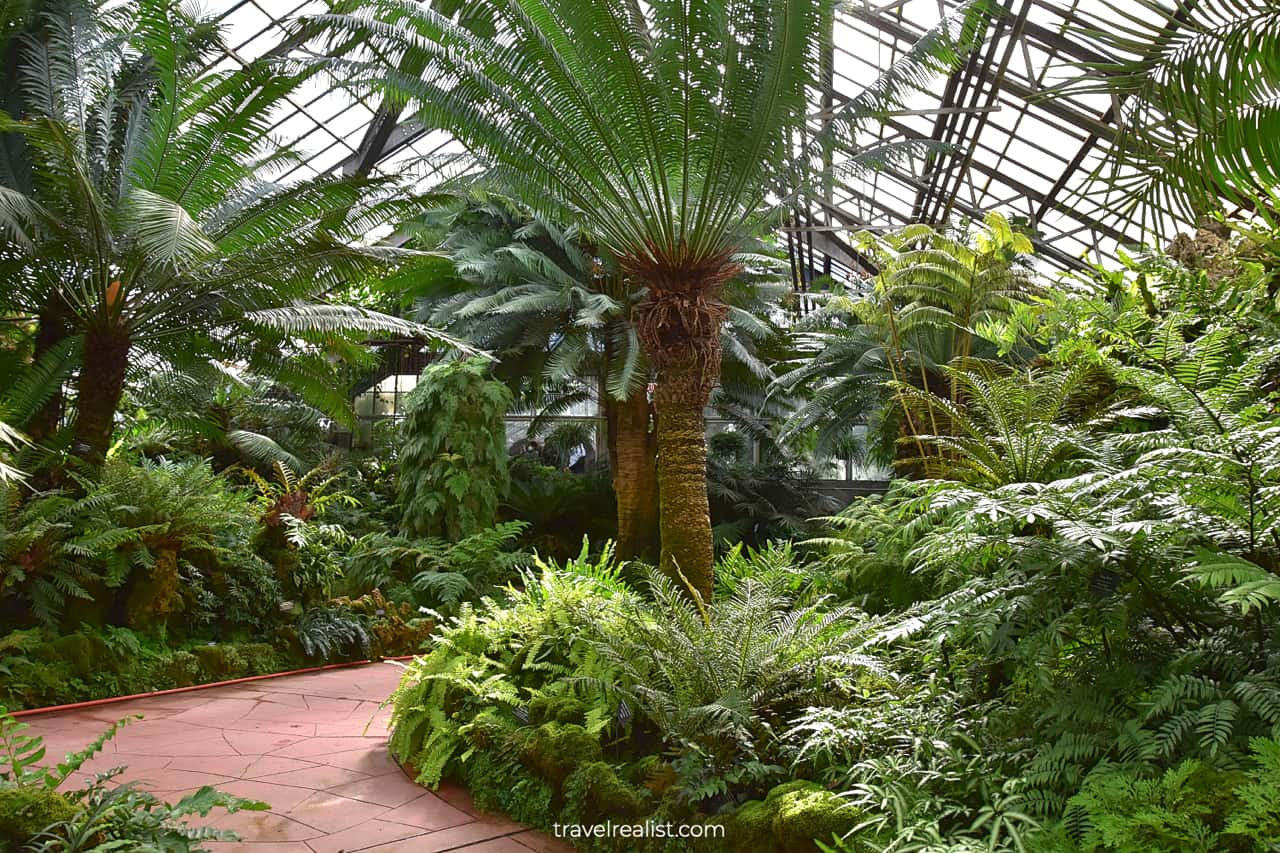
2.2. Indoor Ponds
The Fern Room in the Lincoln Park Conservatory has two indoor ponds. These ponds help set and keep the humidity level in the Fern room. They act as natural humidifiers for the plants in the Fern Room.
If having a couple indoor ponds is not enough to surprise you, look for live fish. Giant koi fish call these ponds their home. You could watch them swim at a leisurely pace for a few minutes.

3. Orchid House
The Orchid House is the next stop on this Lincoln Park Conservatory Review. This room sets the conservatory apart from other botanical gardens across the US and abroad.
It also helps Lincoln Park score a few points over its neighbor on the West Side of Chicago. The Garfield Park Conservatory does not have a comparable orchid collection.
There are very few parks and gardens that could rival Lincoln Park Conservatory when it comes to orchids. Only the gardens in Hillwood Estate in Washington, D.C. come close.
The Orchid House has everything to be your favorite chamber in the Lincoln Park Conservatory. But it will be in a different league if you visit the Orchid House when the flowers are in bloom.
Purple, blue, white, yellow, and red flowers will be overpowering. Their beauty and smell alone will make a visit to the Lincoln Park Conservatory worth your time.

3.1. Orchid
As the name of the room gives away, orchids are the main plants in the Orchid House. You will see them nearly everywhere.
The orchids will be growing in pots on both sides of the path. These pots will be in rows at different heights. Some orchids will also be in baskets hanging from the ceiling.
This placement makes it easier for people of all ages and heights to enjoy their beauty. It is an amazing reminder of the benefits of an accessible environment.
A keen eye would notice water pipes on the ceiling. This pipe placement is another distinctive feature of the Lincoln Park Conservatory. You could find such pipes in nearly every chamber of this conservatory.
These water pipes are used for misting and watering. They also ensure that the plants closer to the ceiling get their fair share of water.

3.2. Pitcher Plant
It might be hard to believe but orchids are not the only exotic plants in the Orchid House. You could find a handful of other interesting plants if you keep your eyes peeled.
A Pitcher Plant is quite difficult to miss. This tropical plant grows in baskets that hang from the greenhouse ceiling. If you have never heard of pitcher plants you might enjoy some context.
Pitcher plants are carnivores. It means that these plants trap animals and insects and consume them. So, the beauty of these plants is deadly.
These plants have developed pitchers from leaves. They emit nectar to lure their prey. An unsuspecting insect goes deeper and deeper into the pitcher.
The plant then shuts down the only entrance, trapping an insect inside. Do not count on seeing an animal being trapped in a Pitcher Plant during your visit.
But go online and see this process for yourself. A few nature documentaries display the entire sequence. Without a doubt, you should see these plants in action at least once.
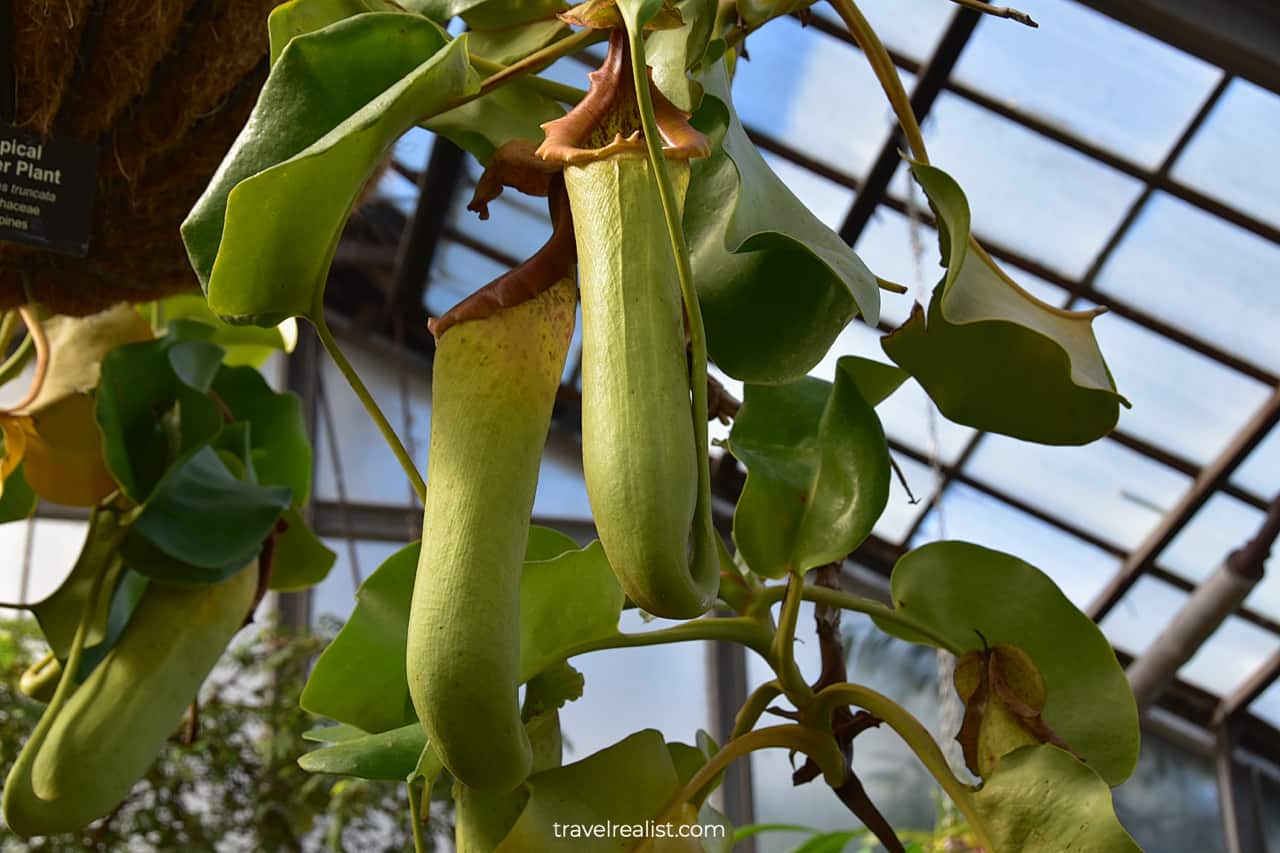
3.3. Flaming Sword Bromeliad
The Lincoln Park Conservatory has a beautiful Flaming Sword Bromeliad plant. This exotic plant is a not so distant relative to a pineapple.
Resist any temptation to touch or taste Flaming Sword Bromeliad. The plant is not toxic. But these unwanted interactions could damage this delicate and beautiful plant.
It is interesting to see the differences in the plant presentation between two conservatories in Chicago. Flaming Sword Bromeliad plants surround palm trees en mass in the Garfield Park Conservatory.
But the plant in the Lincoln Park Conservatory has a much taller sword. It is a true centerpiece of one of displays in the Orchid House.
The Orchid House is not the last room in the Lincoln Park Conservatory. You could choose to go to the Palm House through the Show House.
The Conservatory often places temporary exhibitions in this chamber. But there might not be much to see there depending on the time of your visit.

4. Lincoln Park
You would need to exit the conservatory via the Palm House. While your visit to the Lincoln Park Conservatory is ending, your exploration of Lincoln Park is just starting.
Lincoln Park is a beautiful city park. It has a lot of similarities with the world famous parks in major US cities. First and foremost, Lincoln Park has a zoo.
This setup is similar to Central Park in NYC, Griffith Park in Los Angeles, and Balboa Park in San Diego. But Lincoln Park Zoo has free admission whereas all other zoos on this list charge entrance fees.

4.1. South Pond
Not everyone likes to see animals in captivity. It can certainly not compare to wildlife watching in Denali, Kenai Fjords, or Northern Iceland.
In this case, you could head to the South Pond or the North Pond. If you are looking for a combination of nature and Chicago Skyline, head down south.
The South Pond is right next to Lincoln Park Zoo and Café Brauer. The latter is a nice stop in a beautiful building that dates back to 1900. You could enjoy a meal or a cup of coffee with a picturesque view.
The former John Hancock Building dominates the view. This 100-story skyscraper is the 5th tallest building in the city.
While you could get a glimpse of Chicago Skyline from Lincoln Park, consider going on an tour. Most Chicago architecture tours take place in the Loop, Oak Park, or Hyde Park neighborhoods.
The Pond has a boardwalk that loops around it. It is a popular spot for tourists and locals. The boardwalk gets busy at times. But you should be on the lookout. The pond and wetlands attract snakes.
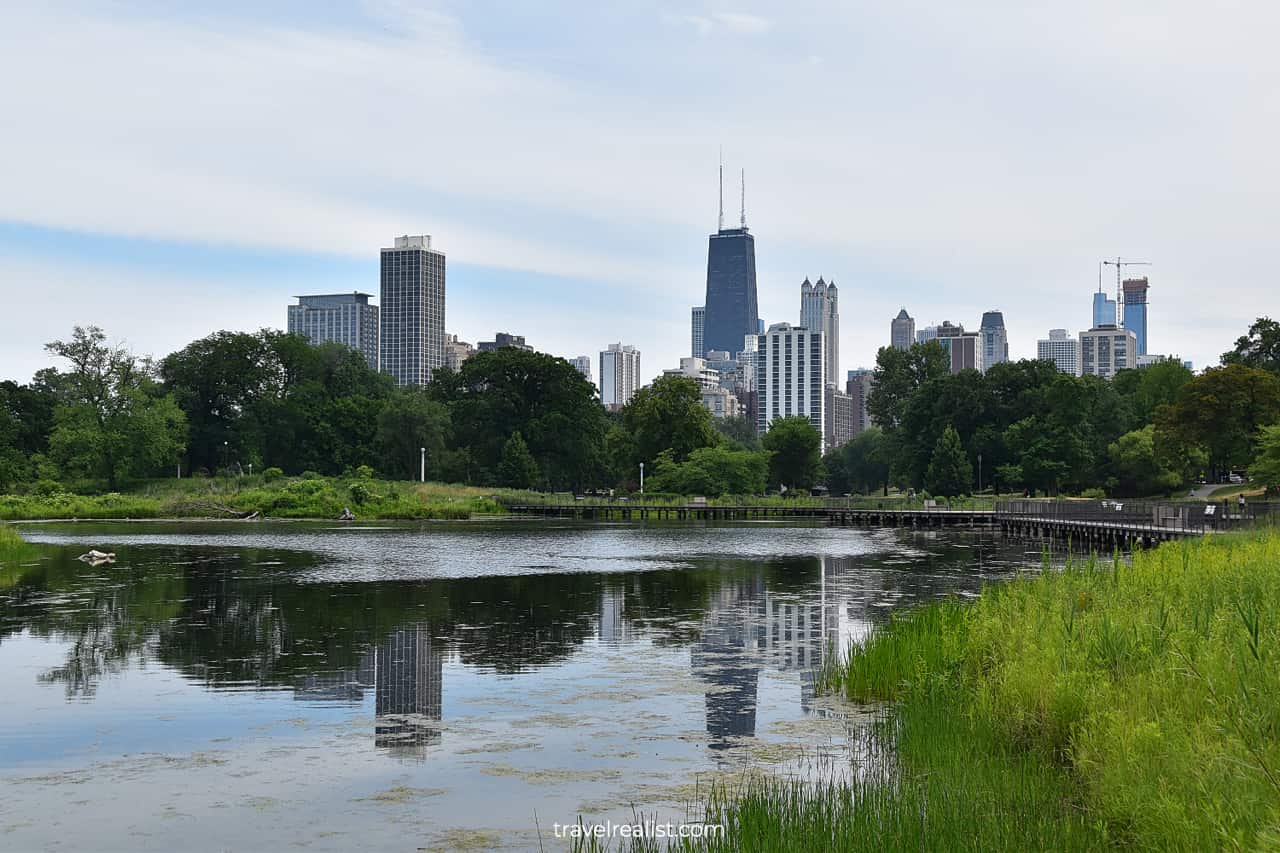
4.2. Ulysses S. Grant Monument
The side of the pond closest to Lake Michigan houses a major monument. It commemorates Ulysses S. Grant, the 18th President of the United States.
The monument dates back to 1891. It has a large granite pedestal with a bronze statue of the President on a horse. This monument has been in the center of a debate following the 2020 protests.

Continue with this Lincoln Park Conservatory Review. You will learn more about ways to get to the sights, entrance requirements, and places to stay.
Getting to Lincoln Park Conservatory
The Lincoln Park Conservatory is at 2391 N Stockton Drive in Chicago, Illinois. The conservatory is slightly north of the Chicago Loop.
It is in the Lincoln Park neighborhood. The neighborhood is on the shore of Lake Michigan. It also borders Near North Side, Bucktown, and Lake View communities.
You could thank the Lincoln Park Conservatory location for access to Chicago Architecture and Lake Michigan tours. You could also reach a few sights south of the Loop, like the Frederick C. Robbie House.
But most locations south and west of Chicago Loop require you to make a connection. While it is not a major inconvenience, every connection adds time to your journey.
Chicago O’Hare (ORD) and Midway (MDW) airports are about the same distance to this conservatory. Yet, a journey from O’Hare will take you 15 extra minutes.

Transportation Options
You cannot easily each the Lincoln Park Conservatory via subway or train. The conservatory is almost a mile (1.6 km) from the nearest subway station. Fullerton is a station on Brown, Purple, and Red L Lines.
You would need to walk for at least 21 minutes to reach the conservatory from there. At least you will be walking through one of the safest neighborhoods in the city.
Clybourn train station is even further away. It will take you nearly an hour to cover 2.1 miles (3.4 km) to the conservatory. This is hardly an easy way to reach your destination.
On the bright side, you could take a bus to the Lincoln Park Conservatory. Bus 151 Sheridan brings you to the conservatory from Loop in under 40 minutes. Get off at Stockton & Fullerton.
Buses 22 Clark and 36 Broadway have slightly longer journey times. The bus stop Clark & Fullerton is three blocks from the conservatory.
Biking is also an option for visiting the Lincoln Park Conservatory. A Divvy bike station is across the street from the destination. You could also take the Lakefront Trail if you are biking to the conservatory.
There is no free parking at Lincoln Park. You need to budget $28 for daily parking near the conservatory. You could also walk to Lincoln Park from the Loop if you have 90+ minutes to spare.
Here is a recap of the transportation options in the order of ease of use and cost.
- Bus: $2.25 one way or $5 for a day pass.
- L Subway: $2.5 one way or $5 for a day pass.
- Car: paid parking at $28 per day.
- Bike: $1 + $0.17 per minute or $16.5 for a day pass.
- Walk: free.

Where to Stay near Lincoln Park
The Lincoln Park Conservatory is in one of the safest areas of Chicago. As a result, there are a lot of places to stay nearby. You could even find one within a walking distance to the conservatory if you prefer.
In this case, look no further than Best Western Plus Hawthorne Terrace Hotel. This is a great choice a bit north of the Lincoln Park Conservatory.
Hyatt Place Chicago Wicker Park is another solid option. You would need to take a bus to Lincoln Park. But you could go to most other sights via subway or train.
You could choose to find a place to stay further north, along the Purple L Line. In this case, look for places to stay in Rogers Park and Evanston.
Both communities are home to the well known universities. As a result, there are plenty of places to stay near the subway stations. Staying there could also bring sizable savings.
Take a closer look at Hampton Inn Chicago North-Loyola Station, Il and Hyatt House Chicago/Evanston. Both are excellent places to stay further north from Lincoln Park.
Regardless of where you choose to stay, visit Chicago restaurants. Try a deep dish pizza at Pequod’s Pizza or stop by Michelin featured Smoque BBQ. Both places are in the vicinity of Lincoln Park.

Entrance Requirements & Passes
The Lincoln Park Conservatory is open Wednesday to Sunday throughout the year. You could visit the conservatory between 10 a.m. and 5 p.m. Last admission is at 4:00 p.m. daily.
Just like the Garfield Park Conservatory, the Lincoln Park Conservatory is free to visit. But unlike its West Side counterpart, this conservatory has a suggested donation. It is $10 per adult and $5 per child.
Since it is a suggested amount, you can decide for yourself if this conservatory is worth your donation. You should not feel pressured to donate if you choose not to.
You need to get a reservation in advance of your visit to tour the Lincoln Park Conservatory. The conservatory releases reservations 4 weeks in advance.
There is no reservation fees to secure a spot to the Lincoln Park Conservatory. But since more people visit Lincoln Park than Garfield Park, it could be more challenging to secure a spot.
Try making a reservation as soon as you finalize your travel plans. This way, you could guarantee a visit to this marvelous greenhouse.

Takeaways: Lincoln Park Conservatory Review
The Lincoln Park Conservatory is a solid stop on a day trip to Chicago. It is a great place to learn more about exotic plants and broaden your knowledge. Make memories as you stroll through this greenhouse.
You could combine a visit to the conservatory with an exploration of Lincoln Park. A bike ride on the Lakefront Trail will bring you back to the Loop.
You could visit the Willis Tower or take an architecture tour from there. Chicago Loop is also the major transportation hub for flying in and out of the city.
Lincoln Park Conservatory vs. Garfield Park Conservatory
A comparison between the conservatories in Lincoln Park and Garfield Park is inevitable. Some things are similar between the two greenhouses.
- They are in the same city, some 7 miles (11 km) apart.
- Both conservatories date back to same period.
- Neither charges admission fees.
- Yet, both require advance reservations.
But the Lincoln Park Conservatory and the Garfield Park Conservatory are worlds apart in other respects.
- Lincoln Park is one of the safest neighborhoods while Garfield Park ranks dead last in crime rate.
- Buses and bikes are the main transport modes to Lincoln Park Conservatory.
- Subway stops right next to Garfield Park Conservatory.
- Parking is free at Garfield Park but costs nearly $30 at Lincoln Park.
- You would need more time to explore the greenhouse at Garfield Park.
You should try to visit both conservatories if you enjoy plants and nature. Decide whether you enjoy desert and aroid plants more than orchid and fruit trees. It will help you narrow down your selection.
If you are forced to choose one greenhouse, go with the Garfield Park Conservatory. Easier access with public transport, larger chambers, and desert plants outweigh a rougher neighborhood.
Take a look at this Video List of the Best Places to Visit in and near Chicago. And visit the YouTube channel for the latest videos.

Frequently Asked Questions
Lincoln Park Conservatory in Chicago gives you a great way to learn more about tropical plants.
– See palms and fruit trees in the Palm House.
– Tell a difference between a cycad and a palm in the Fern House.
– Enjoy blooming orchids in the Orchid House.
– See seasonal exhibits in the Show House.
You could take a stroll along the North or South Ponds after your visit to the conservatory. Stop by the free zoo, enjoy a beverage in Café Brauer, and see Chicago Skyline reflections.
Lincoln Park Conservatory in Chicago dates back to 1895. This Victorian Glass Building is nearly 130 years old.
There are a few ways to reach Lincoln Park Conservatory. You could choose between a car, public transportation, a bike, and a walk.
– Bus: take Bus 151 to Stockton & Fullerton or Buses 22/36 to Clark & Fullerton.
– Subway: take Red, Purple, or Brown L train to Fullerton station and walk from there.
– Car: there is a parking lot behind the greenhouse. It costs $28 per day.
– Bike: rent a Divvy bike to the station across the street from the conservatory.
– Walk: take a 3.5-mi walk to the park from Chicago Loop.
Make sure you secure a free reservation in advance. You cannot go into the conservatory unless you have a reservation. Walk-ins are not welcome.
Lincoln Park Conservatory is at 2391 N Stockton Drive in Chicago, IL. The greenhouse is in the middle of Lincoln Park, near the intersection of Stockton Drive and Fullerton Avenue.
Reservations to visit Lincoln Park Conservatory open 4 weeks in advance.
Safe realist travels!




